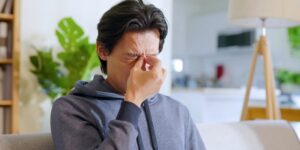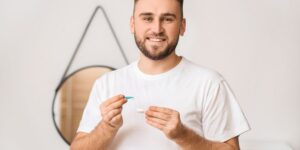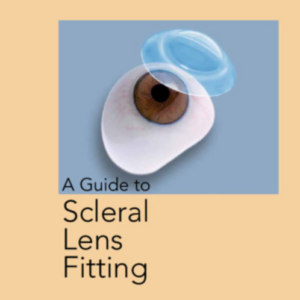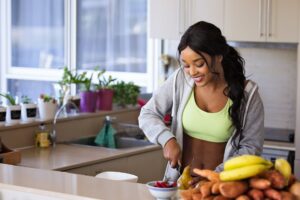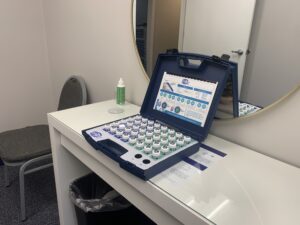Scleral contact lenses are a type of specialty contact lens that can provide improved vision and comfort for individuals with certain eye conditions. In this section, we will explore what Scleral Lens Insertions are, who can benefit from them, and how they work.
What are Scleral Contact Lenses?
Scleral contact lenses are larger in diameter compared to traditional contact lenses. They are designed to vault over the entire cornea and rest on the white part of the eye, known as the sclera. This unique design allows scleral lenses to create a tear-filled reservoir between the lens and the cornea, providing a smooth and comfortable fit.
The main purpose of scleral lenses is to correct vision and provide a protective barrier for the cornea. They can be used to address various eye conditions such as keratoconus, extreme dry eyes, and post-refractive surgery complications. Scleral lenses are also beneficial for individuals with irregular corneas or those who have had corneal transplants.
Who Can Benefit from Scleral Lenses?
Scleral lenses are particularly beneficial for individuals who have been unsuccessful with traditional contact lenses or are unable to undergo laser eye surgery. They can provide visual improvement and comfort for patients with conditions such as keratoconus, where the cornea becomes thin and cone-shaped, resulting in distorted vision.
Additionally, individuals with extreme dry eyes, often associated with conditions like Sjögren’s syndrome or graft-versus-host disease, can benefit from scleral lenses. The tear reservoir created by the lenses helps to keep the cornea hydrated and protected from the drying effects of the environment.
Post-refractive surgery patients, such as those who have undergone radial keratotomy (RK), may also find relief with scleral lenses. These lenses can help to correct any remaining refractive errors and provide improved vision.
How Scleral Lenses Work
Scleral lenses work by creating a liquid-filled space between the cornea and the lens itself. This space, often referred to as the “tear reservoir,” acts as a cushion, protecting the cornea and providing a smooth optical surface for light to pass through. The fluid-filled reservoir also helps to improve comfort by providing constant lubrication for the eye.
To ensure a proper fit, scleral lenses are custom-made for each individual. This involves a detailed fitting process conducted by a qualified eye care professional. The fitting process includes measurements of the cornea and sclera to determine the appropriate lens size and shape.
Once the lens is fitted, it can be inserted into the eye using a specialized scleral lens plunger. This tool helps to hold and guide the lens onto the eye without touching the lens surface, reducing the risk of damage. For a step-by-step guide on lens insertion, refer to our article on scleral lens insertion.
By understanding the fundamentals of scleral contact lenses, including what they are, who can benefit from them, and how they work, individuals with specific eye conditions can explore the potential benefits of these specialized lenses. Consulting with a qualified eye care professional is essential to determine if scleral lenses are the right option for your unique needs.
Scleral Lens Insertion
Inserting scleral contact lenses may seem intimidating at first, but with the right preparation and guidance, it can become a routine part of your eye care routine. In this section, we will discuss the steps involved in scleral lens insertion, including how to prepare for the process, a step-by-step guide, and troubleshooting common issues that may arise.
Preparing for Lens Insertion
Before inserting scleral lenses, it is important to ensure that your hands are clean and free of any debris or oils that could potentially contaminate the lenses. Thoroughly wash your hands with a mild, fragrance-free soap and dry them with a lint-free towel.
Gather all the necessary supplies, including your scleral lenses, scleral lens solution, and a scleral lens plunger or inserter. It may be helpful to have a mirror nearby to aid in the insertion process.
Step-by-Step Guide to Scleral Lens Insertion
Start by inspecting the lenses for any damage or debris. Rinse them with the recommended scleral lens solution to ensure they are clean.
Fill the bowl of the lens with the prescribed sterile saline or artificial tears. Make sure the lens is submerged completely.
Hold the lens on the inserter or plunger, making sure it is centered.
Look straight ahead into the mirror and use your non-dominant hand to gently hold your upper eyelid upward.
With your dominant hand, use your middle finger to pull down your lower eyelid.
Slowly bring the lens toward your eye, tilting it slightly to allow the saline to flow into your eye.
Look downward and gently place the lens onto your eye, aiming to position it centrally. Avoid blinking until the lens is in place.
Once the lens is on your eye, release your eyelids and gently blink to center the lens.
Repeat the process for the other eye.
Troubleshooting Common Issues
While inserting scleral lenses, you may encounter a few common issues. Here are some troubleshooting tips:
Lens Fogging:
If your lenses fog up during insertion, try rewetting them with a few drops of sterile saline or artificial tears before placing them on your eyes. Additionally, make sure your lenses are clean and free from debris.
Discomfort:
If you experience discomfort, double-check that the lens is centered properly. Blinking gently can help the lens settle into place. If discomfort persists, consult your eye care professional.
Lens Dislodgment:
If the lens becomes dislodged during insertion, remove it, rinse it with the recommended solution, and try again. Make sure to hold your eyelids properly and position the lens centrally.
Remember, it may take some practice to become comfortable with the process of inserting scleral lenses. If you are having difficulty, don’t hesitate to reach out to your eye care professional for guidance and assistance. They can provide personalized advice and tips based on your specific needs and requirements.
In the next section, we will discuss the proper care and maintenance of scleral lenses to ensure their longevity and your ocular health.
Caring for Scleral Lenses
Once you have successfully undergone scleral lens insertion, proper care and maintenance are essential to ensure their longevity and maintain optimal eye health. This section will guide you through the necessary steps in cleaning and disinfection, lens removal and storage, and follow-up care and maintenance.
Cleaning and Disinfection
Maintaining clean and disinfected scleral lenses is crucial to prevent the buildup of debris and reduce the risk of infection. Here are some important steps to follow:
Wash your hands:
Before handling your lenses, thoroughly wash your hands with mild soap and water. Rinse them well to remove any residue.
Remove the lenses:
Carefully remove the lenses from your eyes using a scleral lens plunger or other recommended tools. Be gentle and avoid any excessive force that could damage the lenses.
Rinse the lenses:
Rinse the lenses with preservative-free saline solution to remove any debris or residue. Avoid using tap water or homemade saline solutions, as they may contain harmful microorganisms.
Clean the lenses:
Apply a few drops of prescribed cleaning solution to each lens. Gently rub the lenses with your fingers, following the specific instructions provided by your eye care professional.
Rinse again:
Rinse the lenses thoroughly with saline solution to remove any remaining cleaning solution.
Disinfect the lenses:
Place the lenses in a clean lens case filled with a recommended disinfecting solution. Follow the instructions provided by your eye care professional for the appropriate soaking time.
Remember to use only the solutions recommended by your eye care professional, as different solutions may not be compatible with certain lens materials. For more information on scleral lens cleaning and scleral lens solution, refer to our articles on scleral lens cleaner and scleral lens solution.
Lens Removal and Storage
Proper lens removal and storage are essential to maintain the condition and safety of your scleral lenses. Here’s what you need to know:
Wash your hands:
Before removing your lenses, wash your hands thoroughly with mild soap and water. Dry them with a lint-free towel.
Fill the lens case:
Fill the lens case with fresh, preservative-free saline solution or the recommended storage solution provided by your eye care professional.
Remove the lenses:
Using the appropriate tools, gently remove the lenses from your eyes. Be cautious not to drop the lenses or apply excessive pressure.
Inspect the lenses:
Check the lenses for any signs of damage, deposits, or fogging. If you notice any issues, consult your eye care professional for guidance.
Store the lenses:
Place each lens in the lens case, ensuring they are fully submerged in the solution. Close the case securely to prevent contamination.
Follow-up Care and Maintenance
Regular follow-up care and maintenance appointments with your eye care professional are vital to monitor the health of your eyes and ensure the effectiveness of your scleral lenses. Here are some important considerations:
Follow the recommended schedule:
Attend follow-up appointments as advised by your eye care professional. These visits allow for adjustments, evaluations, and necessary modifications to optimize your lens experience.
Replace lenses as recommended:
Follow the recommended replacement schedule for your scleral lenses. Over time, lenses may accumulate deposits or lose their shape, affecting the fit and comfort.
Adhere to hygiene practices:
Continuously practice good hygiene by washing your hands thoroughly before handling your lenses and following the recommended cleaning and disinfection procedures.
Address concerns promptly:
If you experience any discomfort, redness, or changes in vision, contact your eye care professional immediately. Prompt attention to such issues can help prevent complications.
By following these care and maintenance guidelines, you can ensure the longevity and optimal performance of your scleral lenses. Remember, the specific care routine may vary based on individual needs, so it’s essential to consult with your eye care professional for personalized instructions.
Benefits of Scleral Contact Lenses
Scleral contact lenses offer numerous benefits for individuals with specific eye conditions. These lenses provide a comfortable and effective solution for addressing visual impairments and eye sensitivities. Let’s explore some of the key benefits of scleral contact lenses:
Improved Visual Clarity
One of the primary advantages of scleral contact lenses is their ability to provide improved visual clarity. These lenses are designed to vault over the cornea, creating a smooth and even surface for light to pass through. This helps to correct refractive errors, such as astigmatism, and provide sharper and more accurate vision. Scleral lenses can be particularly beneficial for patients with conditions like keratoconus, where the cornea becomes irregularly shaped. The lenses help to neutralize this irregularity and enhance visual acuity.
Enhanced Comfort for Sensitive Eyes
Individuals with sensitive or delicate eyes often struggle to find comfortable contact lens options. Scleral lenses offer a solution by providing a protective cushion of tears between the lens and the cornea. This cushion helps to reduce friction and irritation, offering a more comfortable wearing experience. The lenses also minimize the risk of debris or irritants coming into contact with the cornea, making them suitable for patients with conditions such as extreme dry eyes or post RK surgery.
Protection and Moisturization for Dry Eyes
Dry eyes can cause significant discomfort and affect visual acuity. Scleral lenses can help alleviate these symptoms by acting as a reservoir for artificial tears. The space between the lens and the cornea acts as a barrier, preventing tears from evaporating too quickly and maintaining a constant moisture level on the surface of the eye. This can provide relief for individuals with chronic dry eye conditions or those who experience excessive tear evaporation.
Scleral contact lenses are a valuable tool for individuals seeking improved vision and comfort. Whether you require better visual clarity, relief for sensitive eyes, or protection for dry eyes, these lenses can make a significant difference. Consult with a qualified eye care professional to determine if scleral lenses are the right option for your specific needs.
Considerations and Precautions
Before opting for scleral contact lenses, it is important to consider certain factors and take necessary precautions to ensure the best possible experience. Here are some key considerations to keep in mind:
Finding a Qualified Eye Care Professional
When considering scleral lenses, it is crucial to consult with a qualified eye care professional who has experience in fitting and managing these specialized lenses. They will be able to assess your specific eye condition, determine if scleral lenses are suitable for you, and guide you through the fitting process.
A qualified eye care professional will take precise measurements of your eyes and provide personalized recommendations for the type of lenses that best suit your needs. They will also educate you on proper lens care, insertion, and removal techniques. To find a qualified professional near you, check out our article on scleral lenses near me.
Insurance Coverage and Cost Considerations
It is important to check with your insurance provider regarding insurance coverage for scleral lenses. While some insurance plans may cover a portion of the cost, others may consider them as elective or cosmetic and provide limited or no coverage at all. Understanding your insurance coverage and potential out-of-pocket expenses will help you plan accordingly.
The cost of scleral lenses can vary depending on various factors, including the complexity of your prescription and the type of lenses recommended for your specific needs. It is advisable to discuss the cost with your eye care professional and inquire about any payment options or financing plans that may be available. For more information on the cost of scleral lenses, you can refer to our article on scleral lens cost.
Potential Risks and Complications
While scleral lenses can provide significant benefits for patients with conditions such as keratoconus, extreme dry eyes, or post-RK surgery, it is important to be aware of potential risks and complications. These may include discomfort, lens fogging, lens dislodgement, corneal abrasion, or infection.
To minimize the risk of complications, it is crucial to follow the advice and instructions provided by your eye care professional. Proper lens hygiene, regular follow-up visits, and adherence to the recommended wearing schedule are essential. If you experience any persistent discomfort, redness, or vision changes while wearing scleral lenses, it is important to consult your eye care professional promptly.
By considering these factors and taking necessary precautions, you can make an informed decision regarding scleral lenses and enhance your vision and comfort. It is always recommended to discuss your specific needs and concerns with a qualified professional who can provide personalized guidance throughout your scleral lens journey. For more information on the fitting process, check out our article on scleral lens fitting.


